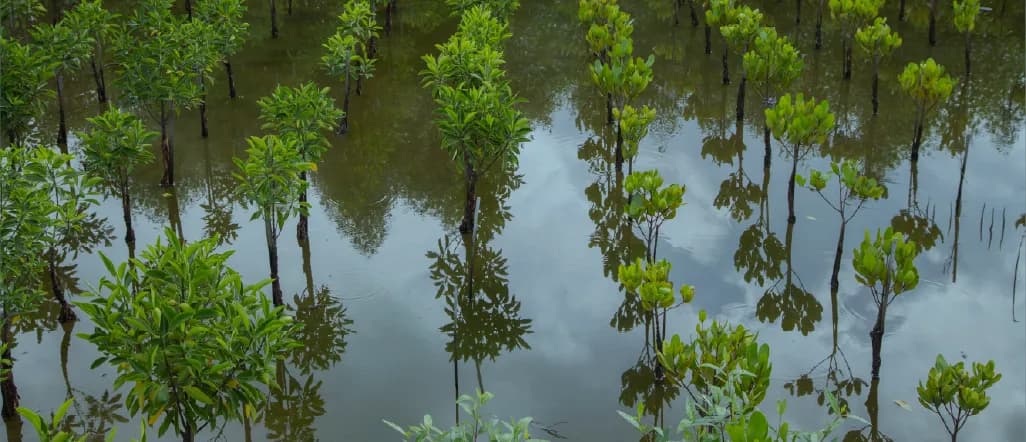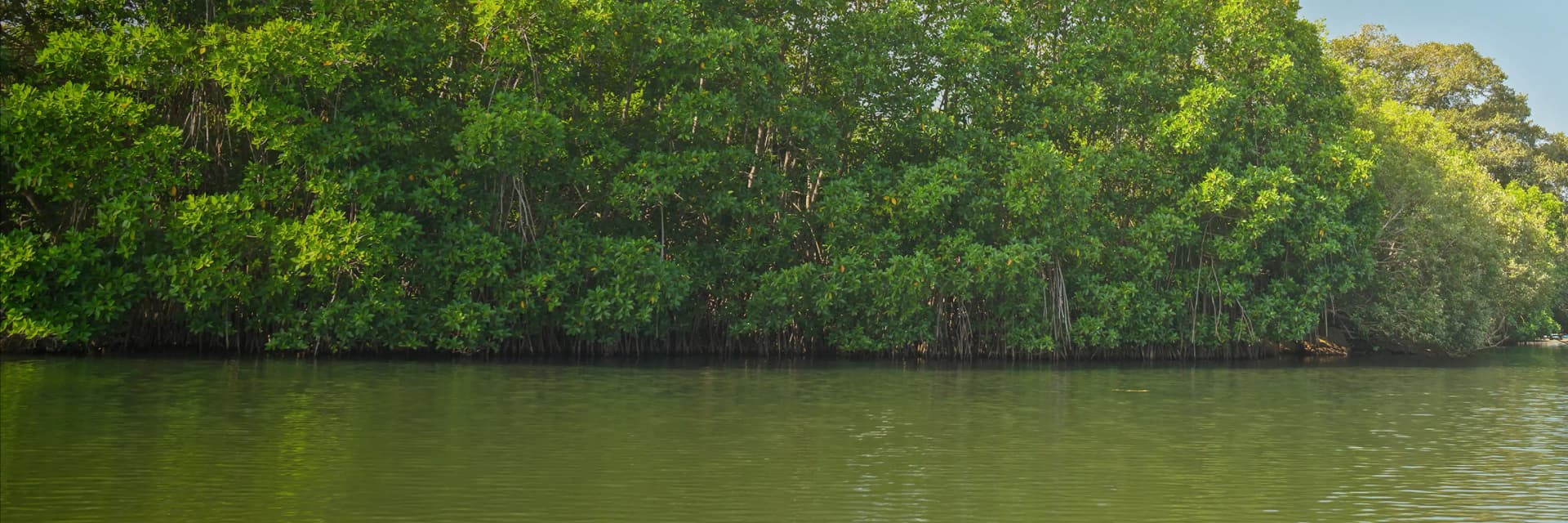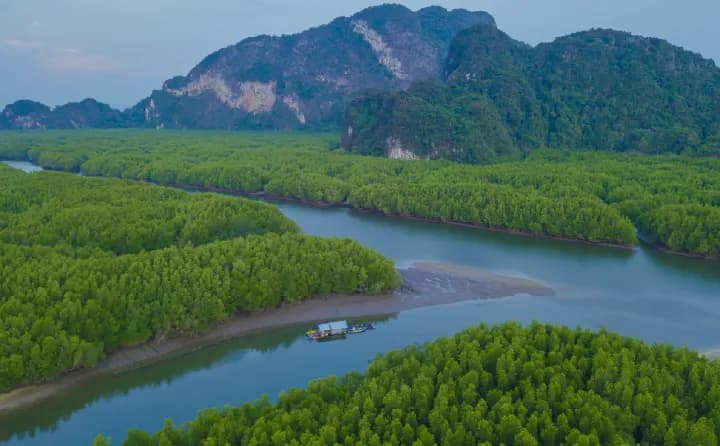Work/Carbon Projects/Blue Carbon/Mangrove Afforestation, Reforestation and Conservation
Mangrove Afforestation, Reforestation and Conservation
Mangrove afforestation, reforestation, and conservation focuses on planting, restoring, and safeguarding these vital coastal ecosystems. 
Importance of Mangrove Afforestation?
Mangrove afforestation, reforestation, and conservation are essential for coastal protection by reducing erosion and storm impacts. They support diverse marine and terrestrial species, enhance water quality, and sequester carbon, helping to mitigate climate change. Additionally, they bolster local economies and provide vital resources, contributing to sustainable livelihoods and ecosystem health.
Mangroves, which are unique coastal ecosystems, play a crucial role in protecting coastlines, providing habitat for diverse species, and mitigating climate change. The loss of mangroves due to human activities, such as deforestation, aquaculture, and urbanization, has led to significant environmental degradation. To address this issue, various programs and initiatives have been implemented worldwide to promote mangrove afforestation, reforestation, and conservation.At ProClime, our approach combines advanced frameworks with a focus on mangrove afforestation, reforestation, and conservation to deliver sustainable, long-lasting results. Suitable sites are identified based on factors like soil, water quality, tidal patterns, and existing vegetation. Mangrove seedlings are propagated in nurseries and then planted in prepared areas, followed by regular care and monitoring. In addition, local communities are empowered to participate in conservation efforts, and long-term strategies are developed to adapt to changing environmental conditions. By following these steps, mangrove ecosystems can be effectively restored and protected.
Mangrove afforestation, reforestation, and conservation involve a series of steps to restore and protect these unique coastal ecosystems. Here's a breakdown of the process:
1. Site Assessment and Selection
Identifying suitable locations involves considering factors like soil conditions, water quality, tidal patterns, and existing vegetation. The ecological and socio-economic conditions also need to be assessed to evaluate the area's biodiversity, potential for coastal protection, and the needs of local communities.
2. Nursery Establishment
Mangrove seedlings are propagated by collecting seeds or cuttings from healthy mangrove trees. These seedlings are grown in controlled conditions, planted in nurseries with appropriate soil, water, and sunlight. The growth and health of the seedlings are monitored to ensure that they are ready for planting.
3. Planting and Care
Planting sites are prepared by clearing the area of debris, invasive species, and any obstructions. The seedlings are then planted by carefully inserting them into the prepared soil, ensuring proper depth and spacing. Initial care is then provided by watering seedlings regularly, protecting them from herbivores, and monitoring their survival rate.
4. Monitoring and Maintenance
Regularly assessing the growth and survival by monitoring the health of the planted mangroves and addressing any issues. Invasive species are controlled by removing plants that can compete with the mangroves for resources. The new mangroves need to be protected from threats by implementing measures to prevent damage from human activities, pollution, and natural disasters.
5. Community Engagement
Empowering local communities by educating them about the importance of mangrove forests. Thereby, promoting sustainable livelihoods by support alternative income sources that do not harm mangroves, such as ecotourism or sustainable fishing. Ultimately, establishing community based management enables locals to take ownership of mangrove conservation efforts.
6. Long-Term Monitoring and Adaptation
Continued monitoring and evaluation is necessary to track the progress of mangrove restoration and adapt strategies as needed. This includes developing plans to mitigate the effects of climate change on mangroves, such as sea-level rise and saltwater intrusion. Finally, promoting research and knowledge sharing to improve the understanding of mangrove ecology and restoration techniques.
Registration Body:

Methodology: VM0033
Program Type:

SDG Goals:

Our Mangrove Afforestation, Reforestation and Conservation Projects
Our major activities to combat climate change and environmental damage through several mitigation options are:

East Coast Mangroves Restoration Project - Eastern Province, Sri Lanka
Trincomalee, Ampara and Batticaloa, Sri LankaBenefits of Project
Why ProClime?
Frequently Asked Questions
Mangroves are unique coastal ecosystems found in tropical and subtropical regions. They are characterized by their salt-tolerant trees and shrubs, which are adapted to thrive in intertidal zones where land meets sea. Mangrove forests are typically found in areas with sheltered coastlines, such as estuaries, deltas, and lagoons.
The Mangrove Afforestation, Reforestation, and Conservation programme is a comprehensive initiative aimed at restoring and protecting mangrove forests worldwide. It focuses on: Afforestation: Planting mangroves in areas where they have never existed before. Reforestation: Restoring mangrove forests in areas where they have been degraded or destroyed. Conservation: Preserving existing mangrove forests through habitat protection, sustainable management, and community engagement.
Mangrove afforestation refers to the process of planting mangrove trees in areas where mangroves did not previously exist. This can involve converting degraded or non-mangrove areas into new mangrove habitats. The aim is often to create new mangrove forests in regions where they can contribute to ecosystem restoration and provide various environmental benefits. Mangrove reforestation, on the other hand, involves restoring mangrove forests in areas where they once existed but have been degraded or destroyed. This process focuses on revitalizing existing mangrove ecosystems to recover their ecological functions and biodiversity. Reforestation efforts may involve planting mangrove species native to the area and ensuring the restoration of the original habitat conditions.
Mangroves are vital for coastal protection, biodiversity, carbon sequestration, and supporting local livelihoods. Their dense root systems act as natural barriers against storms, tsunamis and costal erosion, while their complex ecosystems provide critical habitats for a wide range of species. Mangroves also play a crucial role in mitigating climate change by sequestering large amounts of carbon. Additionally, they offer valuable resources and benefits to local communities, including fisheries, timber, tourism, and recreational activities.
Mangrove conservation and restoration efforts are hindered by several key challenges. One of the most pressing threats is deforestation and land conversion, as mangrove areas are cleared for agriculture, aquaculture, and urban development. This leads to habitat loss and degradation. Climate change poses another significant challenge, with rising sea levels and increased storm intensity negatively impacting mangrove ecosystems. Changes in temperature and precipitation patterns can further disrupt mangrove health and distribution. Additionally, pollution from land-based sources, such as agricultural runoff, industrial discharges, and plastic waste, can damage mangrove ecosystems and harm the species that rely on them. Lack of adequate funding, technical expertise, and local community involvement can also be an issue in some regions.
Our Unique Climate Solutions

Achieve your Sustainability Goals with ProClime
Protect coastal ecosystems and combat climate change with ProClime's Mangrove Afforestation, Reforestation, and Conservation program.
Talk to Our Experts


